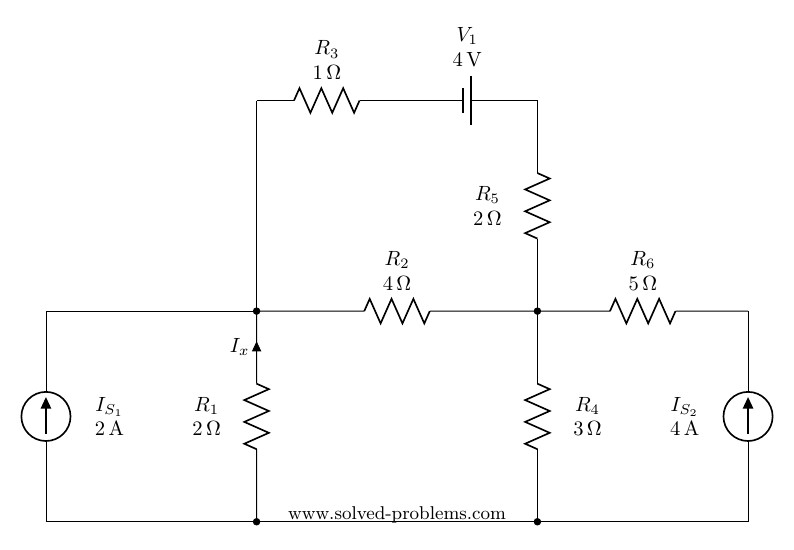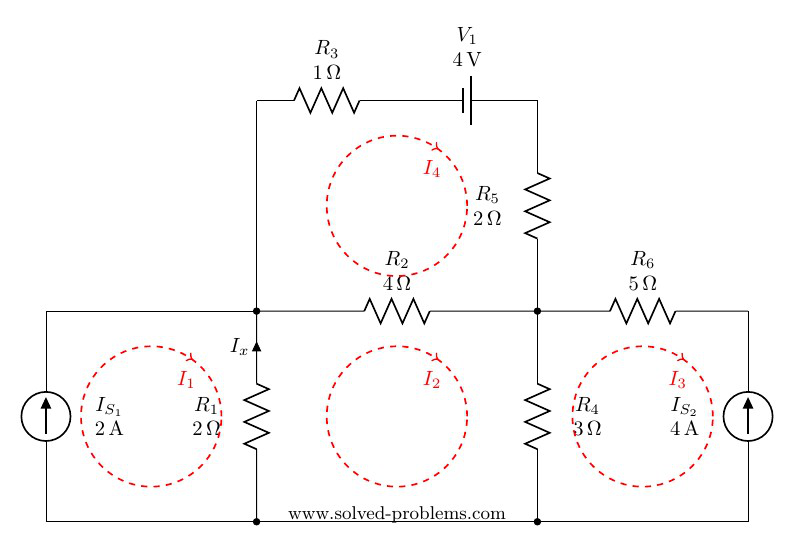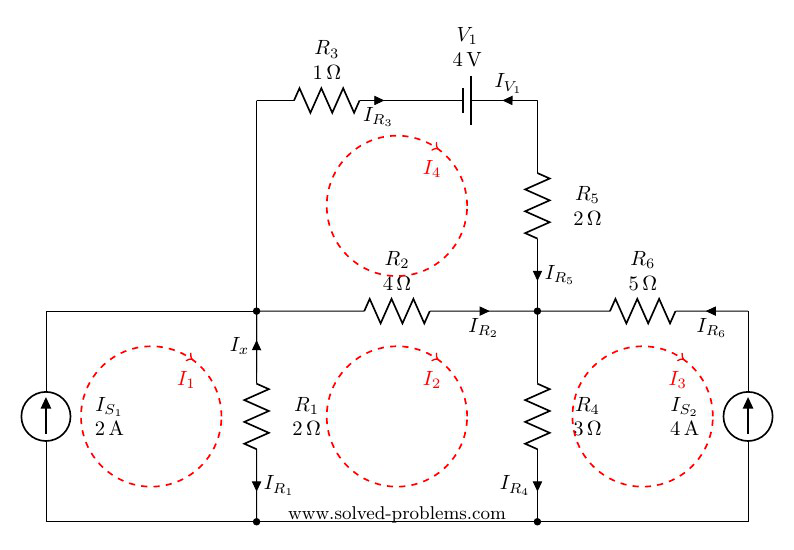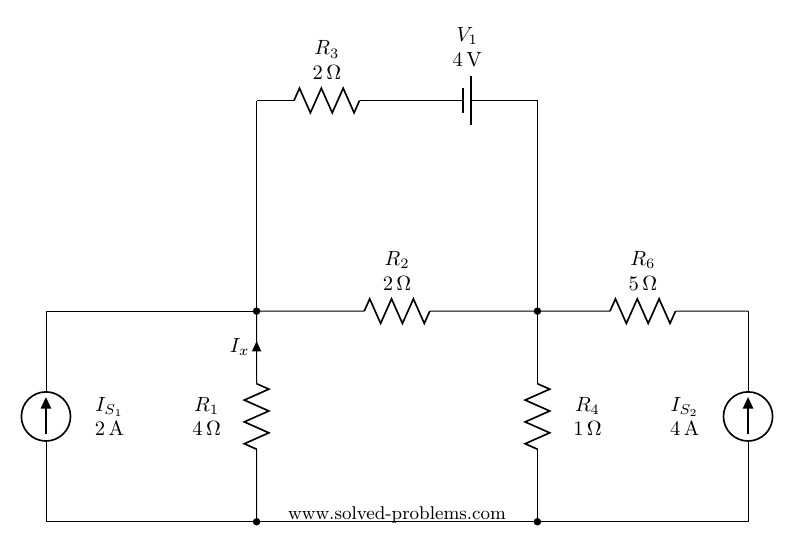Solve the circuit by mesh analysis and find the current ![]() and the voltage across
and the voltage across ![]() .
.

Solution
Mesh Analysis
There are four meshes in the circuit. So, we need to assign four mesh currents. It is better to have all the mesh currents loop in the same direction (usually clockwise) to prevent errors when writing out the equations.
Update 2019/07/27
You may also watch it on YouTube now!

A mesh current is the current passing through elements which are not shared by other loops. This is to say that, for example, the current of ![]() is
is ![]() , the current of
, the current of ![]() is
is ![]() and so on. But how about elements shared between two meshes such as
and so on. But how about elements shared between two meshes such as ![]() ? Current of such elements is the algebraic sum of both meshes. Lets assume that the current of
? Current of such elements is the algebraic sum of both meshes. Lets assume that the current of ![]() is defined with direction from right to left, algebraic sum means that its current would be
is defined with direction from right to left, algebraic sum means that its current would be ![]() . If one assume the inverse direction, i.e. from bottom to top, it would be
. If one assume the inverse direction, i.e. from bottom to top, it would be ![]() because
because ![]() is passing through
is passing through ![]() with the same direction of its defined current but
with the same direction of its defined current but ![]() is passing with the reverse direction.
is passing with the reverse direction.
Lets define current directions for all elements and find them in terms of mesh currents:

Resistors
![]() is shared between mesh #1 and mesh #2, i.e. meshes with currents
is shared between mesh #1 and mesh #2, i.e. meshes with currents ![]() and
and ![]() . Therefore
. Therefore ![]() equals to the algebraic sum of
equals to the algebraic sum of ![]() and
and ![]() . To determine signs of mesh currents for
. To determine signs of mesh currents for ![]() , we need to compare mesh current directions with the
, we need to compare mesh current directions with the ![]() direction. It is clear that
direction. It is clear that ![]() is in the same direction of
is in the same direction of ![]() and
and ![]() is in the opposite direction. Thus,
is in the opposite direction. Thus, ![]() .
.
As we discussed earlier, ![]() .
.
![]() is not shared between meshes. It is only in mesh #4 and because
is not shared between meshes. It is only in mesh #4 and because ![]() is in the same direction of
is in the same direction of ![]() ,
, ![]() .
.
Similar to ![]() :
: ![]() .
.
Similar to ![]() :
: ![]() .
.
It is similar to ![]() with one exception; the direction of
with one exception; the direction of ![]() is opposite to the direction of the mesh current, i.e.
is opposite to the direction of the mesh current, i.e. ![]() . Therefore,
. Therefore, ![]() .
.
Voltage Source
Similar to ![]() , since the defined current direction is opposite to the mesh current direction:
, since the defined current direction is opposite to the mesh current direction: ![]() .
.
Current Sources
Current sources are known but finding their values in term of mesh currents helps to find mesh current values.
It is not shared between any mesh and in the same direction as the mesh current. Thus ![]()
It is not shared between any mesh and in the reverse direction of the mesh current. Thus ![]()
Known and unknown mesh currents
Current sources, specially when they are not shared between meshes, are very useful in determining mesh current values. SO far we have found:
![]()
![]()
But ![]() and
and ![]() are still unknown.
are still unknown.
Now, lets write the equation for mesh of ![]() (Mesh II). A mesh equation is in fact a KVL equation using mesh currents. We start from a point and calculate algebraic sum of voltage drops around the loop. We try to avoid introducing more unknowns to equations than the mesh currents. For example, instead of
(Mesh II). A mesh equation is in fact a KVL equation using mesh currents. We start from a point and calculate algebraic sum of voltage drops around the loop. We try to avoid introducing more unknowns to equations than the mesh currents. For example, instead of ![]() , we use
, we use ![]() . With some practice, you can easily write KVL equations using mesh currents directly. For resistors, the voltage drop equals to the resistance multiplied by mesh currents considering mesh currents in your KVL writing direction with positive sign and for the ones in the opposite direction with negative sign. Lets assume for mesh 2 we start from left-bottom toward top:
. With some practice, you can easily write KVL equations using mesh currents directly. For resistors, the voltage drop equals to the resistance multiplied by mesh currents considering mesh currents in your KVL writing direction with positive sign and for the ones in the opposite direction with negative sign. Lets assume for mesh 2 we start from left-bottom toward top:
![]()
![]() is in the same direction of our KVL and therefore comes with positive sign but
is in the same direction of our KVL and therefore comes with positive sign but ![]() is in the opposite direction and comes with negative sign. Similarly:
is in the opposite direction and comes with negative sign. Similarly:
![]()
![]()
![]()
![]() (1)
(1)
For Mesh IV, starting from left-bottom toward top and then right:
![]()
This is because ![]() is not a shared element.
is not a shared element.
![]()
![]()
![]() (2)
(2)
Solving equations 1 and 2, we obtain:
![]()
Finding 
The current of any branch is equal to the algebraic sum of associated mesh currents. ![]() is in the opposite direction of
is in the opposite direction of ![]() and
and ![]() is in the same direction as
is in the same direction as ![]() . Therefore:
. Therefore:
![]() .
.
Finding voltage across 
![]()
![]() .
.
When To Use Mesh Analysis?
It depends on the number of meshes in the circuit comparing to the number of nodes. If there are more meshes than nodes, it is usually better to use mesh analysis.
Homework
Solve this circuit using mesh analysis and find ![]() and
and ![]() :
:

Answers
![]()
![]()
Leave a Reply